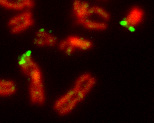The pseudoautosomal regions, PAR1, PAR2,[1] are homologous sequences of nucleotides on the X and Y chromosomes.

The pseudoautosomal regions get their name because any genes within them (so far at least 29 have been found for humans)[2] are inherited just like any autosomal genes. PAR1 comprises 2.6 Mbp of the short-arm tips of both X and Y chromosomes in humans and great apes (X and Y are 154 Mbp and 62 Mbp in total). PAR2 is at the tips of the long arms, spanning 320 kbp.[3]
Location
edit
The locations of the PARs within GRCh38 are:[4]
| Name | Chromosome | Basepair start | Basepair stop | Band[5] |
|---|---|---|---|---|
| PAR1 | X | 10,001 | 2,781,479 | Xp22 |
| Y | 10,001 | 2,781,479 | Yp11 | |
| PAR2 | X | 155,701,383 | 156,030,895 | Xq28 |
| Y | 56,887,903 | 57,217,415 | Yq12 |
The locations of the PARs within GRCh37 are:
| Name | Chromosome | Basepair start | Basepair stop |
|---|---|---|---|
| PAR1 | X | 60,001 | 2,699,520 |
| Y | 10,001 | 2,649,520 | |
| PAR2 | X | 154,931,044 | 155,260,560 |
| Y | 59,034,050 | 59,363,566 |
Inheritance and function
editNormal male mammals have two copies of these genes: one in the pseudoautosomal region of their Y chromosome, the other in the corresponding portion of their X chromosome. Normal females also possess two copies of pseudoautosomal genes, as each of their two X chromosomes contains a pseudoautosomal region. Crossing over between the X and Y chromosomes is normally restricted to the pseudoautosomal regions; thus, pseudoautosomal genes exhibit an autosomal, rather than sex-linked, pattern of inheritance. So, females can inherit an allele originally present on the Y chromosome of their father.
The function of these pseudoautosomal regions is that they allow the X and Y chromosomes to pair and properly segregate during meiosis in males.[6]
Genes
edit
Pseudoautosomal genes are found in two different locations: PAR1 and PAR2. These are believed to have evolved independently.[8]
PAR1
edit- pseudoautosomal PAR1[9]
in mice, some PAR1 genes have transferred to autosomes.[10]
PAR2
editPathology
editPairing (synapsis) of the X and Y chromosomes and crossing over (recombination) between their pseudoautosomal regions appear to be necessary for the normal progression of male meiosis.[13] Thus, those cells in which X-Y recombination does not occur will fail to complete meiosis. Structural and/or genetic dissimilarity (due to hybridization or mutation) between the pseudoautosomal regions of the X and Y chromosomes can disrupt pairing and recombination, and consequently cause male infertility.
The SHOX gene in the PAR1 region is the gene most commonly associated with and well understood with regards to disorders in humans,[14] but all pseudoautosomal genes escape X-inactivation and are therefore candidates for having gene dosage effects in sex chromosome aneuploidy conditions (45,X, 47,XXX, 47,XXY, 47,XYY, etc.).
Deletions have also been associated with Léri-Weill dyschondrosteosis[15] and Madelung's deformity.
See also
editReferences
editExternal links
edit